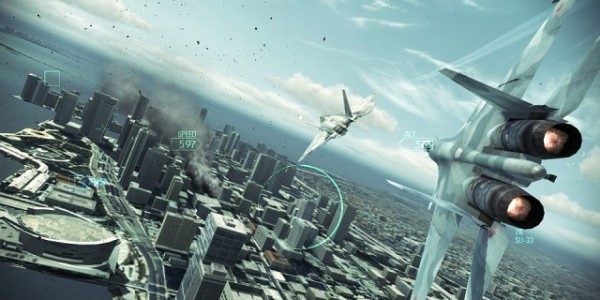It must be tempting for game developers to try to replicate the Call of Duty business model because of the tremendous success it has had within the last few years. It seems that this was the mindset behind the latest Namco Bandai flight simulator, Ace Combat: Assault Horizon. For better or worse, Project Aces has undoubtedly tried to make their own version of Modern Warfare in the skies. This new reboot attempts to appeal to the mainstream but takes the risk of alienating hardcore fans of the series over the years. While the game does many things right, there are only a few aspects of the game that haven’t already been done, and many features of the game will probably be seen and improved upon in games like Call of Duty: Modern Warfare 3.
Ace Combat: Assault Horizon strives to make a more realistic experience than previous entries. First and foremost this is seen with the story. From the onset, gamers will likely be familiar with the premise: Russians have nuclear weapons and are threatening to blow things up, so it’s your job to stop them. Not only has this been done to death, the narrative doesn’t present itself well, either. There are few memorable characters and the dialogue is laughable at times. The game also tries to imitate the cutscenes that the Call of Duty franchise does so well. However, it results in boring experiences such as the main character simply walking down a hallway with absolutely no dialogue and dull scenery (I mean, it’s a hallway). If any interested gamer is looking for an engaging story, there isn’t one to be found here.
It’s clear that the developer wanted to put together a flight simulator that is much more accessible and geared toward a wider audience. This is evidenced by the arcade-style controls that are much simpler than previous entries in the series. Flying the jets and helicopters is fairly straightforward, making it easy to pick up and play. The game gives missions that always entail destroying enemies or buildings but the way that players carry out these orders is thrilling and exciting. The new game mechanic, DFM or Dogfight Mode, is nothing short of spectacular. When engaging an enemy plane, the game puts the player directly at its rear, and through jarring maneuvers at breakneck speeds the gamer must carefully time and aim rockets to take down the target. This sense of excitement during DFM is one of the best and most polished aspects of the experience. To break up these sections are helicopter missions: ASM or Air Strike Mode. These sections put the player on a largely on-rails experience, taking out enemies and buildings from behind a turret. This aspect of the game is seen largely in the Call of Duty games, and while it’s a nice change of pace, it feels more like a shooter experience than a flight simulator.

The game’s missions, while fun to begin, tend to drag on. While DFM is exhilarating, there isn’t much depth in the game; each mission comes down to blowing up targets A and B. The game puts the player in control of one air vehicle and there aren’t any squad commands; this leads to each objective being “blow everything you see to smithereens,” without much strategy. For those who have never played a flight simulator, this game provides a great entry point, but those looking for something more tactical will be left empty-handed.
The game’s online and co-op modes are outstanding features. While not only adding much-needed replay value after the relatively short campaign, going online with friends can be just as fun as the best moments in the single-player campaign. When playing online with friends, DFM can be initiated. These air battles with human opponents are electrifying and really get the blood pumping. Modes in online and co-op are standard affairs, from deathmatch to team assault on enemy bases, but give enough content to keep gamers entertained.
Keeping things realistic, the locations that gamers visit and fly over are all real cities across the world ranging from Miami to Dubai. Each location is intricately detailed to further immerse the player in each dogfight; zooming over familiar terrain makes DFM that much more exciting. The overall presentation is graphically impressive, and the sounds players hear throughout the game are appropriately loud and explosive. The sounds that missiles make when they connect to the desired target are especially satisfying, as well.
I can’t help but feel as if this game is only part of a much fuller game, like Battlefield: Bad Company 2 or Call of Duty: Modern Warfare 2. With the sequels to those games being right around the corner this holiday season, Ace Combat: Assault Horizon will only appeal to those who want a strictly flight-simulator experience. The game will likely have a polarizing effect on their intended audience; the mainstream will praise its accessibility and over-the-top action, while genre enthusiasts will bemoan the simple controls and lack of depth. The game does do a lot of things well, especially the dogfight mode and the realistic representation of major cities across the world, but the rest of the game is straight from other existing military shooters and will presumably be improved upon in their sequels.


















